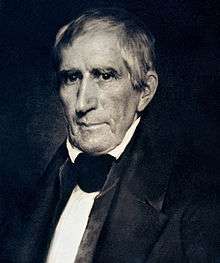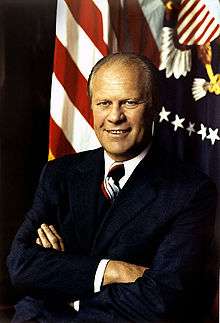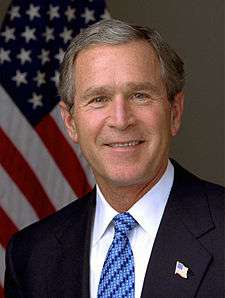English Americans
| Total population | |
|---|---|
|
25,926,451 2010 American Community Survey 24,382,182 2014 American Community Survey 7.6% of the U.S. population[3] | |
| Regions with significant populations | |
|
Throughout the entire United States Predominantly in New England, the Delaware Valley, the Mormon Corridor and the South Plurality in Utah, Maine, Vermont, New Hampshire and Idaho | |
| California | 4,946,554[4] |
| Texas | 3,083,323[4] |
| Ohio | 2,371,236[4] |
| New York | 2,320,503[4] |
| Florida | 2,232,514[4] |
| Michigan | 2,036,021[4] |
| Illinois | 1,808,333[4] |
| North Carolina | 1,778,008[4] |
| Georgia | 1,584,303[4] |
| Tennessee | 1,435,147[4] |
| Pennsylvania | 1,058,737[5] |
| Religion | |
English Americans, also referred to as Anglo-Americans, are Americans whose ancestry originates wholly or partly in England, a constituent country of the United Kingdom of Great Britain and Northern Ireland. In the 2014 American Community Survey, English Americans are (7.6%) of the total population.[2]
However, demographers regard this as a serious undercount, as the index of inconsistency is high, and many, if not most, people from English stock have a tendency (since the introduction of a new "American" category (See Old Stock Americans) in the 2000 census) to identify as simply Americans[6][7][8][9] or if of mixed European ancestry, identify with a more recent and differentiated ethnic group.[10] In the 1980 United States Census, over 49 million (49,598,035) Americans claimed English ancestry, at the time around 26.34% of the total population and largest reported group which, even today, would make them the largest ethnic group in the United States.[11][12] Eight out of the ten most common surnames in the United States are of English origin or having possible mixed British Isles heritage, the other two being of Spanish origin.[13] Scotch-Irish Americans are for the most part descendants of Lowland Scots and Northern English (specifically: County Durham, Cumberland, Northumberland and Westmorland) settlers who colonized Ireland during the Plantation of Ulster in the 17th century.
In 1982, an opinion poll showed respondents a card listing a number of ethnic groups and asked, "Thinking both of what they have contributed to this country and have gotten from this country, for each one tell me whether you think, on balance, they've been a good or a bad thing for this country." The English were the top ethnic group, with 66% saying they were a good thing for the United States, followed by the Irish at 62%.[14]
The overwhelming majority of the Founding Fathers of the United States of America were of English extraction, including Benjamin Franklin, George Washington, John Adams, James Madison[15] and Thomas Jefferson.
English immigrants in the 19th century, as with other groups, sought economic prosperity. They began migrating in large numbers without state support.[16]
Sense of identity
Americans of English heritage are often seen, and identify, as simply "American" due to the many historic cultural ties between England and the U.S. and their influence on the country's population. Relative to ethnic groups of other European origins, this may be due to the early establishment of English settlements; as well as to non-English groups having emigrated in order to establish significant communities.[17]
In the succeeding years since the founding of the United States of America, English-Americans have been less likely to proclaim their heritage in the face of the upsurge of cultural and ethnic pride by African-Americans, Irish-Americans, Scottish-Americans, Italian-Americans or other ethnic groups. While there may be many reasons for this, after centuries of intermarriage and internal geographic mobility, many are unable to determine a specific English origin. For these reasons, no other part of the pluralist American society is so difficult to describe as a separate entity as the English. English immigrants were and are often seen as an invisible ethnic group, due to the length of time their ancestors may have been in the United States, as the majority of the founding colonists were English people.[18]
Number of English Americans
| Number of English Americans | ||||||
|---|---|---|---|---|---|---|
| Year | Ref. | Population | % of the United States population | |||
| 1980 | [19][20] | 49,598,035 | 26.34 | | ||
| 1990 | [21] | 32,651,788 | 13.1 | | ||
| 2000 | [22] | 24,515,138 | 8.7 | | ||
| 2010 | [23] | 25,927,345 | 8.4 | | ||
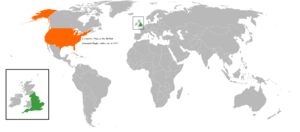
The original 17th-century settlers were overwhelmingly English. From the time of the first permanent English presence in the New World until 1900, these immigrants outnumbered all others, therefore the cultural pattern had been firmly established as the American model.[24]
Colonies from 1700 - 1775
According to the United States Historical Census Data Base (USHCDB), the ethnic populations in the British American Colonies of 1700, 1755 & 1775 were:
| Ethnic composition in the British American Colonies of 1700 • 1755 • 1775[25][26][27] | |||||
|---|---|---|---|---|---|
| 1700 | Percent | 1755 | Percent | 1775 | Percent |
| English and Welsh | 80.0% | English and Welsh | 52.0% | English | 48.7% |
| African | 11.0% | African | 20.0% | African | 20.0% |
| Dutch | 4.0% | German | 7.0% | Scots-Irish | 7.8 % |
| Scottish | 3.0% | Scots-Irish | 7.0% | German | 6.9% |
| Other European | 2.0% | Irish | 5.0% | Scottish | 6.6 % |
| Scottish | 4.0% | Dutch | 2.7% | ||
| Dutch | 3.0% | French | 1.4% | ||
| Other European | 2.0% | Swedish | 0.6% | ||
| Other | 5.3% | ||||
| 100% | | 100% | | 100% | |
Colonial regions and census
| Number of Colonial English-Americans 1776 | |||||
|---|---|---|---|---|---|
| Colonies | Ref. | % of approximate population | |||
| New England | [28] | 70.5% | |||
| Middle | [28] | 40.6% | |||
| Southern | [28] | 37.4% | |||
1790 Census
The 1790 United States Census was the first census conducted in the United States. It was conducted on August 2, 1790. The ancestry of the 3,929,214 population in 1790 has been estimated by various sources by sampling last names in the very first United States official census and assigning them a country of origin.[29] The estimate results indicate that people of English ancestry made up about 47.5% of the total population or 60.9% of the European American population. Some 80.7% of the total United States population was of European heritage.[30] Around 757,208 were of African descent with 697,624 being slaves. Of the remaining population, more than 75% was of British origin.[31]
The states with the highest percentage of English ancestry were Massachusetts 82%, Vermont 76%, Rhode Island 71%, Virginia including West Virginia 68.5%, Connecticut 67%, Maryland including District of Columbia 64.5%, North Carolina 66%, New Hampshire 61%, South Carolina 60.2%, Maine 60%, Delaware 60%, Kentucky and Tennessee 57.9%, Georgia 57.4%, New York 52%, New Jersey 47%, Pennsylvania 35.3%.
2000 Census
| Comparison between the 1790 and 2000 census | |||||
|---|---|---|---|---|---|
| 1790 estimates[32] | 2000 Census[32] | ||||
| Ancestry | Number | % of total | Ancestry | Number | % of total |
| English | 1,900,000 | 47.5 | German | 42,885,162 | 15.2 |
| African | 750,000 | 19.0 | African | 36,419,434 | 12.9 |
| Scotch-Irish | 320,000 | 8.0 | Irish | 30,594,130 | 10.9 |
| German | 280,000 | 7.0 | English | 24,515,138 | 8.7 |
| Irish | 200,000 | 5.0 | Mexican | 20,640,711 | 7.3 |
| Scottish | 160,000 | 4.0 | Italian | 15,723,555 | 5.6 |
| Welsh | 120,000 | 3.0 | French | 10,846,018 | 3.9 |
| Dutch | 100,000 | 2.5 | Hispanic | 10,017,244 | 3.6 |
| French | 80,000 | 2.0 | Polish | 8,977,444 | 3.2 |
| Native American | 50,000 | 1.0 | Scottish | 4,890,581 | 1.7 |
| Spanish | 20,000 | 0.5 | Dutch | 4,542,494 | 1.6 |
| Swedish or other | 20,000 | 0.5 | Norwegian | 4,477,725 | 1.6 |
| 3,929,326[33] | 100 | 281,421,906 | 100 | ||
In the 2000 census, 24.5 million Americans reported English ancestry, 8.7% of the total U.S. population. This estimate is probably a serious undercount by over 30 million given that, in the 1980 census, around 50 million citizens claimed to be of at least partial English ancestry. As many as 80 million Americans may be wholly or partly of English ancestry. In 1980, 23,748,772 Americans claimed wholly English ancestry and another 25,849,263 claimed English along with another ethnic ancestry.[34]
In 1860, an estimated 11 million or almost 35% of the population of the United States was wholly or primarily of English ancestry. The population has increased by almost ten times the numbers in 1860. As with any ethnicity, Americans of English descent may choose to identify themselves as just American ethnicity if their ancestry has been in the United States for many generations or if, for the same reason, they are unaware of their lineages.
English expatriates
In total, there are estimated to be around 678,000 British born expatriates in the United States with the majority of these being English.[35] By American definition there are around 540,000 English people of any race in the United States, 40,000 Asian British, 20,000 Black British people and approximately 10,000 people of a mixed background.[36]
Distribution
States
English Americans are found in large numbers throughout America, particularly in the Northeast, South and West. According to the 2000 US census, the 10 states with the largest populations of self-reported English Americans are:
| The ten states with the most English Americans | States with the highest percentages: | ||||
| 1 | California | (3,521,355 - 7.4% of state population) | 1 | Utah | (29.0%) |
| 2 | Florida | (1,468,576 - 9.2%) | 2 | Maine | (21.5%) |
| 3 | Texas | (1,462,984 - 7%) | 3 | Vermont | (18.4%) |
| 4 | New York | (1,140,036 - 6%) | 4 | Idaho | (18.1%) |
| 5 | Ohio | (1,046,671 - 9.2%) | 5 | New Hampshire | (18.0%) |
| 6 | Pennsylvania | (966,253 - 7.9%) | 6 | Wyoming | (15.9%) |
| 7 | Michigan | (988,625 - 9.9%) | 7 | Oregon | (13.2%) |
| 8 | Illinois | (831,820 - 6.7%) | 8 | Montana | (12.7%) |
| 9 | Virginia | (788,849 - 11.1%) | 9 | Delaware | (12.1%) |
| 10 | North Carolina | (767,749 - 9.5%) | 10 | Colorado, Rhode Island, Washington | (12.0% each) |
English was the highest reported European ancestry in the states of Maine, Vermont and Utah; joint highest along with German in the Carolinas.
Cities
Following are the top 20 highest percentages of people of English ancestry, in U.S. communities with 500 or more total inhabitants (for the total list of the 101 communities, see the reference):[37]
- Hildale, UT 66.9%
- Colorado City, AZ 52.7%
- Milbridge, ME 41.1%
- Panguitch, UT 40.0%
- Beaver, UT 39.8%
- Enterprise, UT 39.4%
- East Machias, ME 39.1%
- Marriott-Slaterville, UT 38.2%
- Wellsville, UT 37.9%
- Morgan, UT 37.2%
- Harrington, ME 36.9%
- Farmington, UT 36.9%
- Highland, UT 36.7%
- Nephi, UT 36.4%
- Fruit Heights, UT 35.9%
- Addison, ME 35.6%
- Farr West, UT 35.4%
- Hooper, UT 35.0%
- Lewiston, UT 35.0%
- Plain City, UT 34.7%
On the left, a map showing percentages by county of Americans who declared English ancestry in the 2000 Census. Dark blue and purple colours indicate a higher percentage: highest in the east and west (see also Maps of American ancestries). Center, a map showing the population of English Americans by state. On the right, a map showing the percentages of English Americans by state.
History

Early settlement and colonization
English settlement in America began with Jamestown in the Virginia Colony in 1607. With the permission of James I, three ships (the Susan Constant, The Discovery, and The God Speed) sailed from England and landed at Cape Henry in April, under the captainship of Christopher Newport,[16] who had been hired by the London Company to lead expeditions to what is now America.[38]
The second successful colony was Plymouth Colony, founded in 1620 by people who later became known as the Pilgrims. Fleeing religious persecution in the East Midlands in England, they first went to Holland, but feared losing their English identity.[39] Because of this, they chose to relocate to the New World, with their voyage being financed by English investors.[40] In September 1620, 102 passengers set sail aboard the Mayflower, eventually settling at Plymouth Colony in November.[41] This story has become a central theme in the United States cultural identity.
A number of English colonies were established under a system of proprietary governors, who were appointed under mercantile charters to English joint stock companies to found and run settlements.
England also took over the Dutch colony of New Netherland (including the New Amsterdam settlement), renaming it the Province of New York in 1664.[42] With New Netherland, the English came to control the former New Sweden (in what is now Delaware), which the Dutch had conquered from Sweden earlier.[43] This became part of Pennsylvania.
English immigration after 1776
| Immigration from England to the United States 1820 - 1970[44][45][46][47] | |||
|---|---|---|---|
| Years | Arrivals | Years | Arrival |
| 1820-1830 | 15,837 | 1901-1910 | 388,017 |
| 1831-1840 | 7,611 | 1911-1920 | 249,944 |
| 1841-1850 | 32,092 | 1921-1930 | 157,420 |
| 1851-1860 | 247,125 | 1931-1940 | 21,756 |
| 1861-1870 | 222,277 | 1941-1950 | 112,252 |
| 1871-1880 | 437,706 | 1951-1960 | 156,171 |
| 1881-1890 | 644,680 | 1961-1970 | 174,452 |
| 1891-1900 | 216,726 | ||
| Arrivals | Total (150 yrs) | 3,084,066 | |
Cultural similarities and a common language allowed English immigrants to integrate rapidly and gave rise to a unique Anglo-American culture. An estimated 3.5 million English immigrated to the U.S. after 1776.[48] English settlers provided a steady and substantial influx throughout the 19th century. The first wave of increasing English immigration began in the late 1820s and was sustained by unrest in the United Kingdom until it peaked in 1842 and declined slightly for nearly a decade. Most of these were small farmers and tenant farmers from depressed areas in rural counties in southern and western England and urban laborers who fled from the depressions and from the social and industrial changes of the late 1820s-1840s. While some English immigrants were drawn by dreams of creating model utopian societies in America, most others were attracted by the lure of new lands, textile factories, railroads, and the expansion of mining.
A number of English settlers moved to the United States from Australia in the 1850s (then a British political territory), when the California Gold Rush boomed; these included the so-called "Sydney Ducks" (see Australian Americans).
During the last years of the 1860s, annual English immigration increased to over 60,000 and continued to rise to over 75,000 per year in 1872, before experiencing a decline. The final and most sustained wave of immigration began in 1879 and lasted until the depression of 1893. During this period English annual immigration averaged more than 82,000, with peaks in 1882 and 1888 and did not drop significantly until the financial panic of 1893.[18] The building of America's transcontinental railroads, the settlement of the great plains, and industrialization attracted skilled and professional emigrants from England.
| England-born in the United States 1850 – 2010[18][49][50] | |||
|---|---|---|---|
| Year | Population | % of foreign-born | % of total population |
| 2010 | 356,489 | 0.9 | |
| 2000 | 423,609 | ||
| 1990 | 405,588 | ||
| 1980 | 442,499 | ||
| 1970 | 458,114 | 4.8 | 0.2 |
| 1960 | 528,205 | 5.4 | 0.3 |
| 1950 | 809,563 | ||
| 1940 | // | ||
| 1930 | 809,563 | 5.7 | 0.7 |
| 1920 | 813,853 | ||
| 1910 | 877,719 | 6.5 | 1.1 |
| 1900 | 840,513 | ||
| 1890 | 908,141 | 9.8 | 1.4 |
| 1880 | 662,676 | ||
| 1870 | 550,924 | 10.0 | 1.4 |
| 1860 | 431,692 | ||
| 1850 | 278,675 | 12.4 | 1.2 |
Also, cheaper steamship fares enabled unskilled urban workers to come to America, and unskilled and semiskilled laborers, miners, and building trades workers made up the majority of these new English immigrants. While most settled in America, a number of skilled craftsmen remained itinerant, returning to England after a season or two of work. Groups of English immigrants came to America as missionaries for the Salvation Army and to work with the activities of the Evangelical and LDS Churches.
The depression of 1893 sharply decreased English emigration to the United States, and it stayed low for much of the twentieth century. This decline reversed itself in the decade of World War II when over 100,000 English (18 percent of all European immigrants) came from England. In this group was a large contingent of war brides who came between 1945 and 1948. In these years four women emigrated from England for every man.[18] In the 1950s, English immigration increased to over 150,000.and rose to 170,000 in the 1960s.[51] While differences developed, it is not surprising that English immigrants had little difficulty in assimilating to American life. The American resentment against the policies of the British government was rarely transferred to English settlers who came to America in the first decades of the nineteenth century.
Throughout American history, English immigrants and their descendants have been prominent in every level of government and in every aspect of American life. Eight of the first ten American presidents and more than that proportion of the 42 presidents, as well as the majority of sitting congressmen and congresswomen, are descended from English ancestors. The descendants of English expatriates are so numerous and so well integrated in American life that it is impossible to identify all of them. While they are the third largest ethnic nationality self-reported in the 1990 census, they retain such a pervasive representation at every level of national and state government that, on any list of American senators, Supreme Court judges, governors, or legislators, they would constitute a plurality if not an outright majority.[52] Today it is estimated that over 80 million Americans are of English ancestry, not including African Americans, who also have some English ancestry.
Political involvement
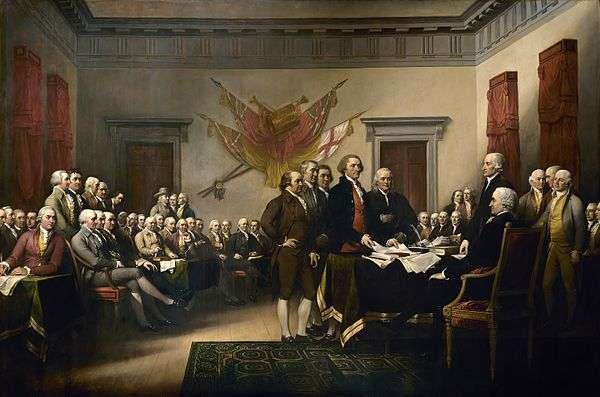
Colonial period
As the earliest colonists of the United States, settlers from England and their descendants often held positions of power and made or helped make laws,[53] often because many had been involved in government back in England.[54] In the original 13 colonies, most laws contained elements found in the English common law system.[55] Of the 55 delegates to the 1787 Constitutional Convention, 49 were Protestants, and two were Roman Catholics (D. Carroll, and Fitzsimons).[56] Among the Protestant delegates to the Constitutional Convention, 28 were Church of England (or Episcopalian, after the American Revolutionary War was won), eight were Presbyterians, seven were Congregationalists, two were Lutherans, two were Dutch Reformed, and two were Methodists.[56]
The Founding Fathers
The lineage of most of the Founding Fathers was English. Such persons include Samuel Adams.[57] Other signatories of the Declaration of Independence, such as Robert Morris were English born.[58] Of the "Committee of Five" (the group delegated to draft the Declaration of Independence), (four of the five) - John Adams of Massachusetts, Benjamin Franklin[59] of Pennsylvania, Thomas Jefferson of Virginia, and Roger Sherman of Connecticut had English roots. The United States Declaration of Independence was written primarily by Thomas Jefferson.
Influence
While WASPs (White Anglo-Saxon Protestants) have been major players in every major American political party, an exceptionally strong association has existed between WASPs and the Republican Party, both in political activity and popular consciousness. Politicians such as Leverett Saltonstall of Massachusetts, Prescott Bush of Connecticut and Nelson Rockefeller of New York exemplified the pro-business liberal Republicanism of their social stratum, espousing internationalist views on foreign policy, supporting social programs, and holding liberal views on issues like racial integration. A famous confrontation was the 1952 Senate election in Massachusetts where John F. Kennedy, a Catholic of Irish descent, defeated WASP Henry Cabot Lodge, Jr.. However the challenge by Barry Goldwater in 1964 to the Eastern Republican establishment helped undermine the WASP dominance.[60] Goldwater himself had solid WASP credentials through his mother, but was instead mistakenly seen as part of the Jewish community (which he had never associated with). By the 1980s, the liberal Rockefeller Republican wing of the party was marginalized, overwhelmed by the dominance of the Southern and Western conservative Republicans.[61]
Language

The English have contributed greatly to American life. Today, English is the most commonly spoken language in the U.S, where it is estimated that two thirds of all native speakers of English live.[62] English was inherited from English colonization, and it is spoken by the vast majority of the population. It serves as the de facto official language: the language in which government business is carried out. According to the 1990 census, 94% of the U.S. population speak only English.[63] Adding those who speak English "well" or "very well" brings this figure to 96%.[63] Only 0.8% speak no English at all as compared with 3.6% in 1890. American English differs from British English in a number of ways, the most striking being in terms of pronunciation (for example, American English retains voicing of the letter "R" after vowels, unlike standard British English) and spelling (a classic example being the "u" in words such as color, favor (US) vs colour, favour (UK)). Less obvious differences are present in grammar, vocabulary, and slang usage. The differences are rarely a barrier to effective communication between American English and British English speakers, but there are certainly enough differences to cause occasional misunderstandings, usually surrounding slang or region dialect differences. The two are however generally treated as mutually intelligible.
Some states, like California, have amended their constitutions to make English the only official language, but in practice, this only means that official government documents must at least be in English, and does not mean that they should be exclusively available only in English. For example, the standard California Class C driver's license examination is available in 32 different languages.
Expressions
"In for a penny, in for a pound" is an expression to mean, ("if you're going to take a risk at all, you might as well make it a big risk"), is used in the United States which dates back to the colonial period, when cash in the colonies was denominated in Pounds, shillings and Pence.[64] Today, the one-cent coin is commonly known as a penny. A modern alternative expression is "In for a dime, in for a dollar".
American cultural icons

Much of American culture also shows influences from English culture.
American flag
- Flag of the United States - Based on the British Grand Union Flag, which is considered to be the first national flag of the United States, and was first flown on December 2, 1775.
Cuisine
- Apple pie - New England was the first region to experience large-scale English colonization in the early 17th century, beginning in 1620, and it was dominated by East Anglian Calvinists, better known as the Puritans. Baking was a particular favorite of the New Englanders and was the origin of dishes seen today as quintessentially "American", such as apple pie and the oven-roasted Thanksgiving turkey.[65] "As American as apple pie" is a well-known phrase used to suggest that something is all-American.
- Roast Beef - In the middle of the 17th century a second wave of English immigrants began arriving in North America, settling mainly in the Chesapeake Bay region of Virginia and Maryland, expanding upon the Jamestown settlement. There roast beef was often served with Yorkshire puddings and horseradish sauce. (It was despised by the French.)
Harvest festivals
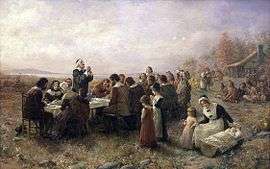
- Thanksgiving — In England, thanks have been given for successful harvests since pagan times. The celebrations on this day usually include singing hymns, praying, and decorating churches with baskets of fruit and food in the festival known as Harvest Festival, Harvest Home or Harvest Thanksgiving. In the U.S. it has become a national secular holiday (official since 1863) with religious origins, but in England it remains a Church festival giving thanks to God for the harvest. The first Thanksgiving was celebrated by English settlers to give thanks to God for helping the Pilgrims of Plymouth Colony survive the brutal winter.[66] The modern Thanksgiving holiday traces its origins from a 1621 celebration at the Plymouth Plantation, where the Plymouth settlers held a harvest feast after a successful growing season. William Bradford is credited as the first to proclaim the American cultural event which is generally referred to as the "First Thanksgiving".
Sports
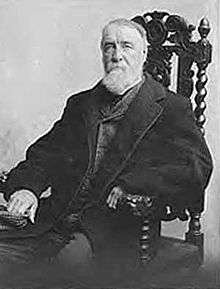
- Baseball - English lawyer William Bray recorded a game of baseball on Easter Monday 1755 in Guildford, Surrey; Bray's diary was verified as authentic in September 2008.[67][68] This early form of the game was apparently brought to North America by British immigrants. The first appearance of the term that exists in print was in "A Little Pretty Pocket-Book" in 1744, where it is called Base-Ball. Today, Rounders which has been played in England since Tudor times holds a similarity to Baseball. Although, literary references to early forms of "base-ball" in the United Kingdom pre-date use of the term "rounders".[69]
- American football - can be traced to early versions of rugby football, played in England and first developed in American universities in the mid-19th century.[70]
Music
Another area of cultural influence are American Patriotic songs:
- American national anthem - takes its melody from the 18th-century English song "To Anacreon in Heaven" written by John Stafford Smith from England for the Anacreontic Society, a men's social club in London and lyrics written by Francis Scott Key of English descent. This became a well-known and recognized patriotic song throughout the United States, which was officially designated as the U.S. national anthem in 1931.[71][72][73]
- Hail to the Chief - is the song to announce the arrival or presence of the President of the United States. English songwriter James Sanderson (c. 1769 – c. 1841), composed the music and was first performed in 1812 in New York.[74]
Before 1931, other songs served as the hymns of American officialdom.
- The Liberty Song - written by John Dickinson of English descent in 1768 to the music of Englishman William Boyce's "Heart of Oak", is perhaps the first patriotic song written in America. The song contains the line "by uniting we stand, by dividing we fall", the first recorded use of the sentiment.
- My Country, 'Tis of Thee - whose melody was indirectly derived from the British national anthem,[75] also served as a de facto anthem before the adoption of "The Star-Spangled Banner."[76]
- Amazing Grace - written by English poet and clergyman John Newton became such an icon in American culture that it has been used for a variety of secular purposes and marketing campaigns, placing it in danger of becoming a cliché.[77]
- Yankee Doodle - is written and accredited to Englishman Dr. Richard Shuckburgh an army doctor. The tune comes from the English nursery rhyme Lucy Locket.[78]
English family names
Of the top ten family names in the United States, eight have English origins or having possible mixed British Isles heritage, the other two being of Spanish origin. This is the first time two surnames of non-British Isles origin have been in the top 10 most common family names. Many African Americans have their origins in slavery (i.e. slave name). Many of them came to bear the surnames of their former owners. Many freed slaves either created family names themselves or adopted the name of their former master. According to 2000 U.S. Census data, eight of the top ten surnames in the United States are of British Isles origin, while two are the most common surnames among Hispanics.[79] In the last UK Census in 2001, surnames in England can be compared to the United States with 6 of the family names in England being in both their top ten.[80] Many English surnames are also found in Ireland. This is attributable to a number of factors, including the Protestant Plantation of Ireland, the imposition of the Penal Laws in the 1700s which forced many Irish people to Anglicize their surnames, and English ancestry in the Irish population itself, especially in the area around Dublin. Also, in the 9th century, Viking invaders brought many Norse names to Ireland that they had already brought to England when they established and settled the Danelaw. Some Scandinavian names may have been brought to England in pre-Viking times, especially in the North and East, and the Anglo-Normans who invaded Ireland in the 1170s brought many Norman French names which had already spread to England.
| Name | Rank - 2000 | Number | Country of Origin | England - 2001 [80][81] |
| Smith | 1 | 2,376,207 | England,[82] Scotland,[83] Ireland[84] (Common however also among German Americans who are likely originally held the surname "Schmidt") | Smith |
| Johnson | 2 | 1,857,160 | England[85] | Jones |
| Williams | 3 | 1,534,042 | England, Wales[86] | Taylor |
| Brown | 4 | 1,380,145 | England, Ireland, Scotland[87] | Brown |
| Jones | 5 | 1,362,755 | England, Wales[88] | Williams |
| Miller | 6 | 1,127,803 | England, Ireland, or Scotland (Miller can be the anglicized version of Mueller/Müller - a surname from Germany)[89] | Wilson |
| Davis | 7 | 1,072,335 | England, Wales[90] | Johnson |
| García | 8 | 858,289 | Spain[91] | Davies |
| Rodríguez | 9 | 804,240 | Spain[92] | Robinson |
| Wilson | 10 | 783,051 | England, Scotland[93] | Wright |
It should be pointed out, however, that a significant number of non-English immigrants anglicized their surnames. For example, "Smith" may come from German Schmidt, or Dutch Smit; "Johnson" from Norwegian or Danish Johansen, Dutch Jansen, or Swedish Johansson, "Brown" from German Braun, "Miller" from German Müller, and so forth. On the other hand, "Williams",[94] "Jones",[95] and "Davis",[96] which are often associated with Welsh ancestry due to their common occurrence in Wales, are actually mostly English, as Wales has a much smaller population (and diaspora) than England.
English place names in the United States
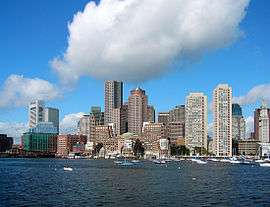
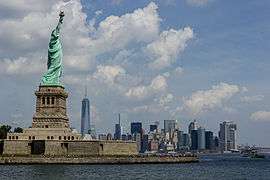
There are many places in the United States named after places in Great Britain as a result of the many British settlers and explorers; in addition, some places were named after the English royal family. These include the region of New England and some of the following:
Alabama
- Birmingham after Birmingham, England
Delaware
- Dover after Dover, England
- Wilmington named by Proprietor Thomas Penn after his friend Spencer Compton, Earl of Wilmington, who was prime minister in the reign of George II of Great Britain.
Georgia
- Georgia was named after King George II.[98]
Maryland
- Maryland named so for Queen Henrietta Maria (Queen Mary).[99]
Massachusetts
- Boston after Boston, England[100]
- Gloucester after Gloucester, England
- Southampton after Southampton, England[101]
- Northampton after Northampton, England
New Hampshire
- New Hampshire state (after Hampshire[102])
- Manchester after Manchester, England[103]
New Jersey
- Burlington County and Burlington after the English east-coast town of Bridlington.[104]
- Gloucester County and Gloucester City after the city of Gloucester / county of Gloucestershire in England.[105]
New York
- New York City (after the Duke of York[106])
Pennsylvania
- Berks County after Berkshire, England
- Bucks County after Buckinghamshire, England
- Chester County and Chester after Chester, England
- Darby derived from Derby (pronounced "Darby"), the county town of Derbyshire (pronounced "Darbyshire")[107]
- Horsham after Horsham, England
- Lancaster County and Lancaster after the city of Lancaster in the county of Lancashire in England, the native home of John Wright, one of the early settlers.[108]
- Reading, Berks County after Reading, Berkshire, England
- Warminster after a small town in the county of Wiltshire, at the western extremity of Salisbury Plain, England.[109]
The Carolinas
- The province, named Carolina (The Carolinas-North and South) to honor King Charles I of England, was divided into SC and NC in 1729, although the actual date is the subject of debate.[110]
Virginia
- The name Virginia was first applied by Queen Elizabeth I (the "Virgin Queen") and Sir Walter Raleigh in 1584.,[111]
Architecture
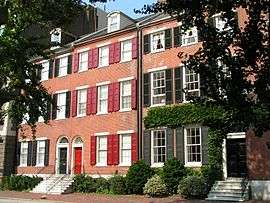
American Architecture, particularly in the nation's earlier years, has long been strongly influenced by English styles. The United States Capitol building, for example, was first designed by English-educated American Architect William Thornton, and bears a resemblance to St Paul's Cathedral in London. Also, many American college campuses, such as Harvard, Penn, Yale, Brown, Williams, Princeton University, and the University of Delaware, have English Georgian or English gothic architecture.
Law
The American legal system also has its roots in English law.[112] For example, elements of the Magna Carta were incorporated into the United States constitution.[113] English law prior to the revolution is still part of the law of the United States, and provides the basis for many American legal traditions and policies. After the revolution, English law was again adopted by the now independent American States.[114]
Presidents of English descent
| ||||||||
Most of the Presidents of the United States have had English ancestry.[115] The extent of English heritage varies in the presidents with earlier presidents being predominantly of colonial English Yankee stock. Later US Presidents' ancestry can often be traced to ancestors from multiple nations in Europe, including England.
- George Washington (English)
- 1st President 1789–97 (great-grandfather, John Washington from Purleigh, Essex, England.[116][117])
- John Adams (English)
- 2nd President 1797–1801 (great-great-grandfather, Henry Adams born 1583 Barton St David, Somerset, England, immigrated to Boston, Massachusetts.[118][119])
- Thomas Jefferson (English and Scots-English)
- 3rd President 1801–09 (Maternal English ancestry from William Randolph.)
- James Madison (English)
- 4th President 1809–17[15]
- John Quincy Adams (English)
- 6th President 1825–29 (Henry Adams born 1583 Barton St David, Somerset, England.[118][119])
- William Henry Harrison (English)
- 9th President 1841–41[120]
- John Tyler (English)
- 10th President 1841–45[121]
- Zachary Taylor (English)
- 12th President 1849–50
- Millard Fillmore (English)
- 13th President 1850–53[122]
- Franklin Pierce (English)
- 14th President 1853–57[123]
- Abraham Lincoln (English, Welsh)
- 16th President 1861–65 (Samuel Lincoln baptised 1622 in Hingham, Norfolk, England, died in Hingham, Massachusetts.[124][125])
- Andrew Johnson (Scots-Irish & English)
- 17th President 1865–69[126]
- Ulysses S. Grant (Scots-Irish, English & Scottish)
- 18th President, 1869–77
- Rutherford B. Hayes (English)
- 19th President 1877–81[127]
- James A. Garfield (English, Welsh and French)
- 20th President 1881–81[128]
- Chester A. Arthur (Scots-Irish & English)
- 21st President 1881–85
- Grover Cleveland (Scots-Irish & English)
- 22nd and 24th President, 1885–89 and 1893–97
- Benjamin Harrison (Scots-Irish & English)
- 23rd President, 1889–93
- William McKinley (Scots-Irish & English)
- 25th President, 1897–1901
- Theodore Roosevelt (Scots-Irish, Dutch, Scots, English & French)
- 26th President, 1901–09
- William Howard Taft (Scots-Irish & English)
- 27th President 1909–13[129][130]
- Warren G. Harding (Scots-Irish & English)
- 29th President 1921–23[131]
- Calvin Coolidge (English)
- 30th President 1923–29[132]
- Franklin D. Roosevelt (Dutch, French & English)
- 32nd President 1933–45
- Harry S. Truman (Scots-Irish, English & German)
- 33rd President 1945–53[133][134]
- Lyndon B. Johnson (English)
- 36th President 1963–69
- Richard Nixon (Scots-Irish, Irish, English & German)
- 37th President, 1969–74
- Gerald Ford (English)
- 38th President 1974–77
- Jimmy Carter (Scots-Irish & English)
- 39th President 1977–81 (Thomas Carter Sr. emigrated from England to Isle of Wight County, Virginia.[135])
- Ronald Reagan (Scots-Irish, Irish, English & Scottish)
- 40th President 1981–89: He was the great-grandson, on his father's side, of Irish migrants from County Tipperary who came to America via Canada and England in the 1840s. His mother was of Scottish and English ancestry.[136]
- George H. W. Bush (Scots-Irish, English, Dutch & German)
- 41st President 1989–93: County Wexford historians have found that one of his ancestors, Richard de Clare, Earl of Pembroke nicknamed "Strongbow" offered his military services in the 12th-century Norman invasion of Wexford, Ireland. Strongbow married Aoife, daughter of Dermot MacMurrough, the Gaelic king of Leinster who had welcomed the Norman assistance to regain his throne in Ireland. .[137][138]
- Bill Clinton (Scots-Irish & English)
- 42nd President 1993–2001
- George W. Bush (Scots-Irish, English, Dutch, German & Welsh)
- 43rd President 2001–09: Reynold Bush from Messing, Essex, England emigrated in 1631 to Cambridge, Massachusetts.[139]
- Barack Obama (Luo, English & Irish)
- 44th President 2009–: His maternal ancestors came to America from France, England, Germany, Switzerland and Ireland.[140][141] His ancestors lived in New England and the South and by the 1800s most were in the Midwest. His father was Luo (or Jaluo) from Kenya, and was the first person in his family to travel or live outside of Africa.
See also
- English diaspora
- Americans or American people
- Anglo America
- English (ethnic group)
- Anglo-American relations
- Anglo-Celtic Australian
- Anglosphere
- Philadelphia Main Line
- Boston Brahmin
- British American
- Demographic history of the United States
- English colonial empire
- English place names in the United States
- Scotch-Irish American
- European American
- Immigration to the United States
- List of English Americans
- Scottish American
- Welsh American
- Maps of American ancestries
- White Anglo-Saxon Protestant
- Yankee
- American ethnicity
- White Southerners
- Old Stock Americans
References
- ↑ 2010 American Community Survey
- 1 2 "Selected Social Characteristics in the United States (DP02): 2014 American Community Survey 1-Year Estimates". U.S. Census Bureau. Retrieved February 22, 2015.
- ↑ In the 1980 census, 49,598,035 Americans identified as being of English ancestry, although in later censuses most of these same people identified as being of "American" ancestry, when that was added as an option.
- 1 2 3 4 5 6 7 8 9 10 Table 3. Persons Who Reported at Least One Specific Ancestry Group for Regions, Divisions, and States: 1980.
- ↑ American FactFinder
- ↑ Sharing the Dream: White Males in a Multicultural America By Dominic J. Pulera.
- ↑ Reynolds Farley, 'The New Census Question about Ancestry: What Did It Tell Us?', Demography, Vol. 28, No. 3 (August 1991), pp. 414, 421.
- ↑ Stanley Lieberson and Lawrence Santi, 'The Use of Nativity Data to Estimate Ethnic Characteristics and Patterns', Social Science Research, Vol. 14, No. 1 (1985), pp. 44-46.
- ↑ Stanley Lieberson and Mary C. Waters, "Ethnic Groups in Flux: The Changing Ethnic Responses of American Whites", Annals of the American Academy of Political and Social Science, Vol. 487, No. 79 (September 1986), pp. 82-86.
- ↑ Mary C. Waters, Ethnic Options: Choosing Identities in America (Berkeley: University of California Press, 1990), p. 36.
- ↑ Data on selected ancestry groups.
- ↑ 1980 United States Census
- ↑ Genealogy Data: Frequently Occurring Surnames from Census 2000
- ↑ Ben J. Wattenberg (1985). "Chapter 14. The First Universal Nation". The Good News Is the Bad News Is Wrong. American Enterprise Institute. p. 77. ISBN 978-0-671-60641-1.
- 1 2 "The Fourth President • 1809-1817: James Madison". Archived from the original on January 2, 2010. Retrieved February 14, 2010.
- 1 2 English Emigration.
- ↑ Stanley Lieberson, From many strands: ethnic and racial groups in contemporary América.
- 1 2 3 4 Stephan Thernstrom, Harvard Encyclopedia of American Ethnic Groups
- ↑ www.census.gov Persons Who Reported at Least One Specific Ancestry Group for the United States: 1980
- ↑ "Rank of States for Selected Ancestry Groups with 100,00 or more persons: 1980" (PDF). United States Census Bureau. Retrieved 30 November 2012.
- ↑ "1990 Census of Population Detailed Ancestry Groups for States" (PDF). United States Census Bureau. 18 September 1992. Retrieved 30 November 2012.
- ↑ "Ancestry: 2000". United States Census Bureau. Retrieved 30 November 2012.
- ↑ "Total ancestry categories tallied for people with one or more ancestry categories reported 2010 American Community Survey 1-Year Estimates". United States Census Bureau. Retrieved 30 November 2012.
- ↑ Encyclopedia of North American Immigration. Retrieved 17 March 2015.
- ↑ The Enduring Vision: A History of the American People By Paul Boyer
- ↑ "Scots to Colonial North Carolina Before 1775". Retrieved 17 March 2015.
- ↑ "U.S. Federal Census :: United States Federal Census :: US Federal Census". Retrieved 17 March 2015.
- 1 2 3 Diversity in America By Vincent N. Parrillo
- ↑ From many strands: ethnic and racial groups in contemporary América By Stanley Lieberson, Mary C. Waters
- ↑ Historical U.S population by race
- ↑ Ethnicity in contemporary America: a geographical appraisal By Jesse O. McKee
- 1 2 The Source. Retrieved 17 March 2015.
- ↑ U.S 1790 Census
- ↑ "Bibliography - European-Americans". Retrieved 17 March 2015.
- ↑ "BBC NEWS - Special Reports - Brits Abroad". Retrieved 17 March 2015.
- ↑ "Office for National Statistics (ONS) - ONS". Retrieved 17 March 2015.
- ↑ "Top 101 cities with the most residents of English ancestry (population 500+)". Retrieved 2007-08-02.
- ↑ "Newport, Christopher". Retrieved 17 March 2015.
- ↑ Bassetlaw Museum
- ↑ "Thanksgiving on the Net - The Pilgrims and America's First Thanksgiving". Retrieved 17 March 2015.
- ↑ Pilgrims - Learn English
- ↑ Digital History
- ↑ "New Sweden". Retrieved 17 March 2015.
- ↑ Statistical Abstract of the United States (Page: 89)
- ↑ Statistical Abstract of the United States Immigration by country of origin 1851-1940 (Page: 107)
- ↑ Statistical Abstract of the United States (Page: 92)
- ↑ Immigration to the United States by country 1820-1995
- ↑ "Synonyms Thesaurus with Antonyms & Definitions - Synonym.com". Retrieved 17 March 2015.
- ↑ 1850-2000.
- ↑ Statistical Portrait of the Foreign-Born Population in the United States, 2010
- ↑ "English Americans - History, Contemporary england, Immigration, settlement, and employment, Acculturation and Assimilation". Retrieved 17 March 2015.
- ↑ The Laws of Olde England Stateside, Marcus Hampshire
- ↑ "GI Roundtable Series". Retrieved 17 March 2015.
- ↑ History of Colonial America. Archived from the original on 2009-10-31.
- ↑ "The Colonial Period". Retrieved 17 March 2015.
- 1 2 Lambert, Franklin T. (2003). The Founding Fathers and the Place of Religion in America. Princeton, NJ: Princeton University Press (published 2006). ISBN 978-0691126029. Retrieved 2015-03-07.
- ↑ Laban Adams belongs to the illustrious family of Henry Adams who came from Devonshire, England, about 1636 and settled in Quincy, Massachusetts His great great grandson, Samuel Adams, was the "Father of the Great American Revolution,"
- ↑ UShistory - Robert Morris.
- ↑ Benjamin Franklin Timeline.
- ↑ Gregory L. Schneider, ed. (2003). Conservatism in America Since 1930: A Reader. NYU Press. pp. 289–.
- ↑ Nicol C. Rae, The Decline and Fall of the Liberal Republicans: From 1952 to the Present (1989)
- ↑ Languages Spoken in the United States.
- 1 2 Summary Tables on Language Use and English Ability: 2000 (PHC-T-20). U.S. Census Bureau. Retrieved 2008-02-22.
- ↑ Michener, "Money in the American Colonies".
- ↑ Fischer, pp. 74, 114, 134–39.
- ↑ William Bradford, Of Plymouth Plantation 1620–1647, 85.
- ↑ "BBC NEWS - UK - England - Baseball 'origin' uncovered". Retrieved 17 March 2015.
- ↑ "BBC - South Today - Features - Baseball history". Retrieved 17 March 2015.
- ↑ Telegraph staff and agencies (11 September 2008). "Major League Baseball told: Your sport is British, not American". Telegraph.co.uk. Retrieved 17 March 2015.
- ↑ The New American Sport History. Retrieved 17 March 2015.
- ↑ "John Stafford Smith: Composer of the Star Spangled Banner".
- ↑ Star-Spangled Banner origins
- ↑ Lesley Nelson. "Star Spangled Banner". Retrieved 17 March 2015.
- ↑ The Fourth of July Encyclopedia By James R. Heintze
- ↑ "My country 'tis of thee [Song Collection]". The Library of Congress. Retrieved 2009-01-20.
- ↑ Snyder, Lois Leo (1990). Encyclopedia of Nationalism. Paragon House. p. 13. ISBN 1-55778-167-2.
- ↑ "'Amazing Grace'". NPR.org. 29 December 2002. Retrieved 17 March 2015.
- ↑ Lomax, John A.; Lomax, Alan. American Ballads and Folk Songs. p. 521.
- ↑ Sam Roberts (2007-11-17). "In U.S. Name Count, Garcias Are Catching Up With Joneses". The New York Times. Retrieved 2007-11-18.
- 1 2 www.ucl.ac.uk/paediatric-epidemiology Most common surnames in Britain.
- ↑ Kimberly Powell. "English Surnames: Meanings and Origins". About.com Parenting. Retrieved 17 March 2015.
- ↑ Kimberly Powell. "Smith - Surname Meaning, Origin and Genealogy". About.com Parenting. Retrieved 17 March 2015.
- ↑ "Scottish Surnames". Retrieved 17 March 2015.
- ↑ "A History of Irish Surnames: Is Yours Here?" An example of this was the common Irish surname Mac Gabhann, which meant "son of a smith". Some Mac Gabhanns, living in County Cavan, had their name translated to Smith and it remained that way.
Smith is the fifth most common surname in Ireland.
- ↑ Kimberly Powell. "Johnson (Surname) - Origin and Genealogy". About.com Parenting. Retrieved 17 March 2015.
- ↑ Kimberly Powell. "Williams - Meaning and Origin of This Surname". About.com Parenting. Retrieved 17 March 2015.
- ↑ Kimberly Powell. "BROWN - Surname Meaning, Origin and Genealogy". About.com Parenting. Retrieved 17 March 2015.
- ↑ Kimberly Powell. "JONES - Surname Meaning - Origin for the Surname Jones Genealogy". About.com Parenting. Retrieved 17 March 2015.
- ↑ The Geography of European Surnames
- ↑ Kimberly Powell. "Origin for the Surname "Davis" - Genealogy". About.com Parenting. Retrieved 17 March 2015.
- ↑ Kimberly Powell. "Origin for the Surname Garcia - Genealogy". About.com Parenting. Retrieved 17 March 2015.
- ↑ Kimberly Powell. "Rodriguez Name Meaning and Origin". About.com Parenting. Retrieved 17 March 2015.
- ↑ Kimberly Powell. "Wilson Surname Meaning and Origin". About.com Parenting. Retrieved 17 March 2015.
- ↑ Williams Family History.
- ↑ Jones Family History.
- ↑ Davis Family History.
- ↑ Homberger, Eric (2005). The Historical Atlas of New York City: A Visual Celebration of 400 Years of New York City's History. Owl Books. p. 34. ISBN 0-8050-7842-8.
- ↑ "The State of Maryland". Retrieved 17 March 2015.
- ↑ "The State of Maryland". netstate.com.
- ↑ Boston History.
- ↑ Southampton, Massachusetts.
- ↑ Netstate - New Hampshire.
- ↑ Manchester History.
- ↑ Hutchinson, Viola L. The Origin of New Jersey Place Names, New Jersey Public Library Commission, May 1945. Accessed August 28, 2015.
- ↑ Kane, Joseph Nathan; and Aiken, Charles Curry. The American Counties: Origins of County Names, Dates of Creation, and Population Data, 1950-2000, p. 112. Scarecrow Press, 2005. ISBN 0810850362. Accessed January 21, 2013.
- ↑ 50 States - NY.
- ↑ Gannett, Henry (1905). The Origin of Certain Place Names in the United States. Govt. Print. Off. p. 100.
- ↑ Petition for the Establishment of Lancaster County, February 6, 1728/9
- ↑ "WARMINSTER TOWNSHIP HISTORY". Township of Warminster. Retrieved 2015-07-31.
- ↑ The Split – One Colony Becomes Two from carolana.com
- ↑ In 1584 Sir Walter Raleigh sent Philip Amadas and Arthur Barlowe to lead an exploration of what is now the North Carolina coast, and they returned with word of a regional "king" named "Wingina." This was modified later that year by Raleigh and the Queen to "Virginia", perhaps in part noting her status as the "Virgin Queen." Stewart, George (1945). Names on the Land: A Historical Account of Place-Naming in the United States. New York: Random House. p. 22.
- ↑ "Features - Sources of United States of America Legal Information in Languages Other than English - LLRX.com". Retrieved 17 March 2015.
- ↑ "Magna Charta - Magna Charta". Retrieved 17 March 2015.
- ↑ COMMON LAW V. CIVIL LAW SYSTEMS
- ↑ "Genealogy and Ancestry of Barack Obama and the Other U.S. Presidents".
- ↑ Archived July 10, 2010, at the Wayback Machine.
- ↑ Irvin Haas (1992). Historic Homes of the American Presidents. Courier Dover Publications. ISBN 0-486-26751-2.
- 1 2 Henry Adams born 1583 Barton St David, Somerset, England
- 1 2 "Henry Adams". Retrieved 17 March 2015.
- ↑ "The Ninth President • 1841-1841: illiam Henry Harrison". Archived from the original on January 2, 2010. Retrieved February 14, 2010.
- ↑ Archived January 2, 2010, at the Wayback Machine.
- ↑ Archived May 11, 2010, at the Wayback Machine.
- ↑ "The Fourteenth President • 1853-1857: Franklin Pierce". Archived from the original on February 6, 2010. Retrieved February 14, 2010.
- ↑ The Ancestry of Abraham Lincoln, James Henry Lea, Robert Hutchinson, Houghton Mifflin Company, Boston, 1909, p. 4.
- ↑ "Ancestors of Abraham Lincoln". Retrieved 17 March 2015.
- ↑ Archived May 11, 2010, at the Wayback Machine.
- ↑ "The Nineteenth President • 1877-1881: Rutherford Birchard Hayes". Archived from the original on January 2, 2010. Retrieved February 14, 2010.
- ↑ "The Twentieth President • 1881-1881: James Abram Garfield". Archived from the original on January 2, 2010. Retrieved February 14, 2010.
- ↑ Marck, John T. "William H. Taft". aboutfamouspeople.com. Retrieved 2008-04-14.
- ↑ "The Presidents, William Taft". American Heritage.com. Retrieved 19 November 2009.
- ↑ "Warren Gamaliel Harding". thinkquest.com. Retrieved 2008-04-16.
- ↑ "The Thirtieth President • 1923-1929: Calvin Coolidge". Archived from the original on January 2, 2010. Retrieved February 14, 2010.
- ↑ Marck, John T. "Harry S. Truman". aboutfamouspeople.com. Retrieved 2008-04-16.
- ↑ "The Presidents, Harry S Truman". American Heritage.com. Retrieved 19 November 2009.
- ↑ "Jimmy Carter Library". Retrieved 17 March 2015.
- ↑ "The Presidents, Ronald Reagan". American Heritage.com. Retrieved 19 November 2009.
- ↑ Chrisafis, Angelique (2005-01-27). "Scion of traitors and warlords: why Bush is coy about his Irish links". London: Guardian. Retrieved 13 July 2010.
- ↑ "American Presidents with Irish Ancestors". Directory of Irish Genealogy. Retrieved 15 April 2008.
- ↑ "BBC News - UK POLITICS - George W Bush, Essex boy". Retrieved 17 March 2015.
- ↑ "The Forty-Fourth President • 2009-present: Barack Hussein Obama". Archived from the original on July 10, 2010. Retrieved September 9, 2010.
- ↑ "Ancestry of Barack Obama". William Addams Reitwiesner. Retrieved 2009-12-02.
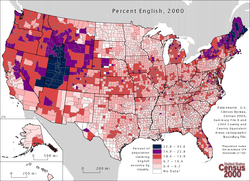

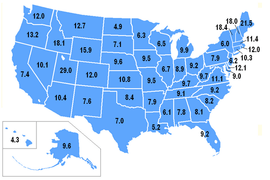

.jpg)
